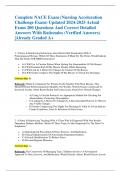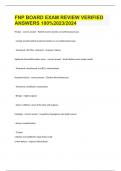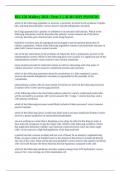Complete NACE Exam (Nursing Acceleration
Challenge Exam) Updated 2024-2025 Actual
Exam 200 Questions And Correct Detailed
Answers With Rationales (Verified Answers)
|Already Graded A+
1. A Nurse Is Reinforcing Instructions About Breast Self-Examination With A
Premenopausal Woman. Which Of These Statements, If Made By The Client, Would Indicate
That She Needs FURTHER Instructions?
• A) I Will Use A Circular Pattern When Feeling For Abnormalities Of My Breasts.
• B) I Will Examine Both Of My Breasts Weekly While Showering.
• C) I Will Look In A Mirror For Changes In Contour Of My Breasts.
• D) I Will Gently Compress The Nipple Of My Breasts To Check For Discharge.
Correct Ans: B)
Rationale: While It’s Important For Women To Be Familiar With Their Breasts, They
Should Perform Self-Examinations Monthly, Not Weekly. Weekly Exams Could Lead To
Increased Anxiety About Breast Health And Unnecessary Alarm Over Normal Changes.
o A) Using A Circular Pattern Is An Appropriate Method For Checking For
Abnormalities, Promoting Thoroughness.
o C) Looking In A Mirror For Changes Is A Recommended Practice To Observe
Any Visible Changes.
o D) Gently Compressing The Nipple For Discharge Is Valid As It Can Indicate
Certain Conditions, Such As Infections Or Duct Issues.
2. A Nurse Is Reinforcing Teaching With A Client Who Is Diagnosed With Non-Insulin-
Dependent Diabetes Mellitus. Which Of These Topics Is Most Important For The Nurse To
Emphasize?
• A) Individualized Prescription Of Diet, Exercise, And Medication.
• B) Clinical Manifestations Of Non-Insulin-Dependent Diabetes.
• C) Lifestyle Modifications To Reduce Stress.
• D) Personal Hygiene Measures.
Correct Ans: A)
Rationale: The Cornerstone Of Managing Type 2 Diabetes Involves A Personalized
Approach To Diet, Exercise, And Medication, Which Directly Affects Blood Glucose Levels.
, o B) While Understanding Clinical Manifestations Is Important, It Is Secondary
To Actively Managing The Condition.
o C) Lifestyle Modifications To Reduce Stress Are Beneficial But Not As
Immediately Critical As Managing Glucose Levels.
o D) Personal Hygiene Is Relevant But Not As Essential For Managing Diabetes
Compared To A Tailored Health Plan.
3. A Nurse Should Assess A Client Who Has A Thyroidectomy For Signs Of Hypocalcemia,
Which Include:
• A) Gingival Hypertrophy.
• B) Painful Joints.
• C) Tetany.
• D) Toothaches.
Correct Ans: C)
Rationale: Tetany, Characterized By Muscle Spasms And Cramps, Is A Classic Symptom Of
Hypocalcemia Due To Potential Damage To The Parathyroid Glands During Thyroid
Surgery.
o A) Gingival Hypertrophy Is Not Related To Hypocalcemia; It Is More
Associated With Certain Medications Or Conditions.
o B) Painful Joints Can Occur For Various Reasons But Are Not A Direct
Indicator Of Hypocalcemia.
o D) Toothaches Are Not Specific To Hypocalcemia And May Arise From
Dental Issues Or Other Systemic Problems.
4. A Nurse Should Expect That A Client Who Has Open-Angle Glaucoma Will Report:
• A) Difficulty Seeing Distant Objects.
• B) Photophobia.
• C) Severe Eye Pain.
• D) Loss Of Peripheral Vision.
Correct Ans: D)
Rationale: Open-Angle Glaucoma Often Leads To Gradual Loss Of Peripheral Vision,
Which Can Progress Unnoticed Until Significant Vision Loss Occurs.
o A) Difficulty Seeing Distant Objects Is More Characteristic Of Refractive
Errors Rather Than Glaucoma.
o B) Photophobia (Sensitivity To Light) Is More Commonly Associated With
Other Eye Conditions, Such As Uveitis Or Migraine.
o C) Severe Eye Pain Is Typically Associated With Acute Angle-Closure
Glaucoma Rather Than Open-Angle Glaucoma.
,5. A Nurse Should Recognize That A Client Who Has A Perineal Prostatectomy Rather Than
A Transurethral Prostatectomy Is More Likely To Develop Which Of These Complications?
• A) Ureteral Stenosis.
• B) Impotence.
• C) Renal Calculi.
• D) Glomerulonephritis.
Correct Ans: B)
Rationale: Perineal Prostatectomy Is Associated With A Higher Risk Of Erectile
Dysfunction Due To Potential Nerve Damage Compared To Transurethral Procedures, Which
Tend To Spare The Nerves Better.
o A) Ureteral Stenosis Is Not Directly Related To The Type Of Prostatectomy
Performed.
o C) Renal Calculi Are Not A Common Complication Of Prostatectomy And
Relate More To Metabolic Issues.
o D) Glomerulonephritis Is A Kidney Condition Unrelated To Prostate Surgery.
6. A Nurse Should Teach A Client Who Has Diabetes Mellitus & Their Family And Friends
To Recognize Early Signs Of A Hypoglycemic Reaction, Which Include:
• A) Irritability.
• B) Fruity Breath.
• C) Double Vision.
• D) Hot, Dry Skin.
Correct Ans: A)
Rationale: Irritability Is A Common Early Sign Of Hypoglycemia Due To The Brain's
Response To Low Glucose Levels.
o B) Fruity Breath Is Indicative Of Hyperglycemia Or Diabetic Ketoacidosis,
Not Hypoglycemia.
o C) Double Vision Can Occur In Various Conditions But Is Not A Primary
Symptom Of Hypoglycemia.
o D) Hot, Dry Skin Is More Characteristic Of Hyperglycemia.
7. A Client Has An Order For 1 Gm Of Medication To Be Administered Intramuscularly. The
Medication Available Is Labeled 500 Mg/Ml. How Many Milliliters Should A Nurse
Administer?
• A) 0.5 Ml
, • B) 1.0 Ml
• C) 2.0 Ml
• D) 3.5 Ml
Correct Ans: C)
Rationale: To Administer 1 Gm (1000 Mg) With A Concentration Of 500 Mg/Ml, You
Would Need 2 Ml.
o A) 0.5 Ml Would Only Provide 250 Mg.
o B) 1.0 Ml Would Only Provide 500 Mg.
o D) 3.5 Ml Would Provide 1750 Mg, Which Exceeds The Order.
8. A Client Who Is Receiving Continuous Bladder Irrigation Has An Intake Of 800 Ml Of
Intravenous Fluid And 2,000 Ml Of Irrigating Solution. The Urinary Drainage Bag Contains
3,800 Ml. The Charted Output Should Be:
• A) 800 Ml.
• B) 1,000 Ml.
• C) 1,800 Ml.
• D) 3,800 Ml.
Correct Ans: C)
Rationale: To Calculate Output, Subtract The Irrigation Input From The Total Output: 3,800
Ml (Drainage) - 2,800 Ml (800 Ml IV + 2,000 Ml Irrigating) = 1,800 Ml.
o A) 800 Ml Does Not Account For The Total Irrigation Input.
o B) 1,000 Ml Also Underestimates The Volume Removed.
o D) 3,800 Ml Is The Total Amount In The Bag, Not The Output.
9. A Vial Of Medication Contains 150 Mg/2 Ml. If A Client Is To Receive 25 Mg Of The
Medication Intramuscularly, How Many Milliliters Should A Nurse Administer To Them?
• A) 0.2 Ml
• B) 0.3 Ml
• C) 0.6 Ml
• D) 1.0 Ml
Correct Ans: B)
Rationale: If 150 Mg Is In 2 Ml, Then 75 Mg Is In 1 Ml. Therefore, 25 Mg Would Require
Approximately 0.3 Ml (1/3 Of 1 Ml).
o A) 0.2 Ml Would Provide Only 20 Mg.
o C) 0.6 Ml Would Provide 60 Mg.
, o D) 1.0 Ml Would Provide 75 Mg, Which Is More Than Ordered.
10. When Caring For A Client During The Immediate Postoperative Period After A Subtotal
Thyroidectomy, It Is Important For A Nurse To:
• A) Ensure That The Client Remains In A Supine Position.
• B) Encourage The Client To Speak Frequently.
• C) Provide The Client With Oral Fluids.
• D) Monitor The Client's Respiratory Status.
Correct Ans: D)
Rationale: After A Subtotal Thyroidectomy, The Risk Of Airway Compromise Due To
Swelling Or Hematoma Formation Necessitates Careful Monitoring Of Respiratory Status.
o A) While The Client May Need To Be In A Supine Position, Monitoring
Respiration Takes Priority.
o B) Encouraging The Client To Speak Can Be Counterproductive, Especially If
The Client Experiences Discomfort Or Swelling.
o C) Providing Oral Fluids May Not Be Appropriate Immediately
Postoperatively Due To The Risk Of Aspiration.
11. Which Of These Actions By A Nurse Would Be Best When Communicating With A
Client Who Has Expressive Aphasia?
• A) Encourage The Client To Verbalize Thoughts.
• B) Involve The Client's Family In Interpreting The Patient's Needs.
• C) Ask Questions Of The Client That Require An Affirmative Or Negative Response.
• D) Attempt To Read The Client's Lip Movements.
Correct Ans: C)
Rationale: Closed-Ended Questions Allow Clients With Expressive Aphasia To Respond
More Easily, Reducing Frustration And Facilitating Communication.
o A) Encouraging Verbalization May Increase Frustration If The Client
Struggles To Find Words.
o B) While Involving Family Can Be Helpful, It May Not Directly Support The
Client's Own Attempts To Communicate.
o D) Attempting To Read Lip Movements May Not Be Effective And Could
Lead To Misunderstandings.
12. A Client Who Has Been On Nothing By Mouth May Now Have Fluids. Which Of These
Beverages Should Be Offered First?






